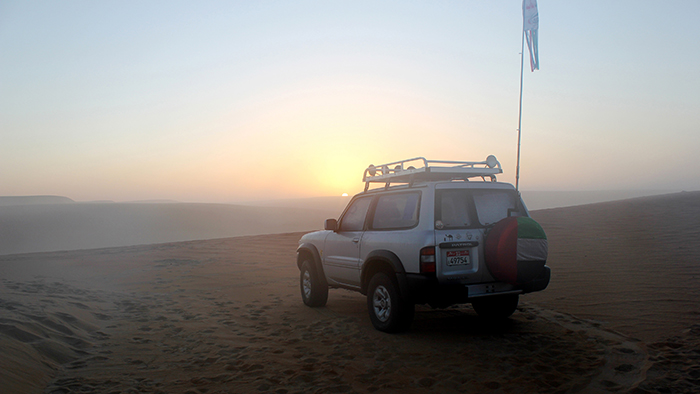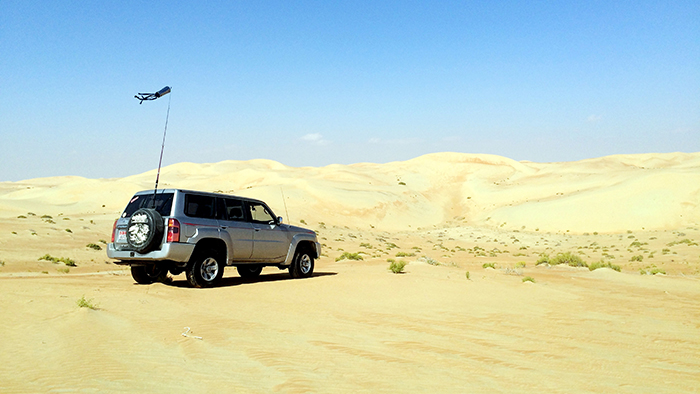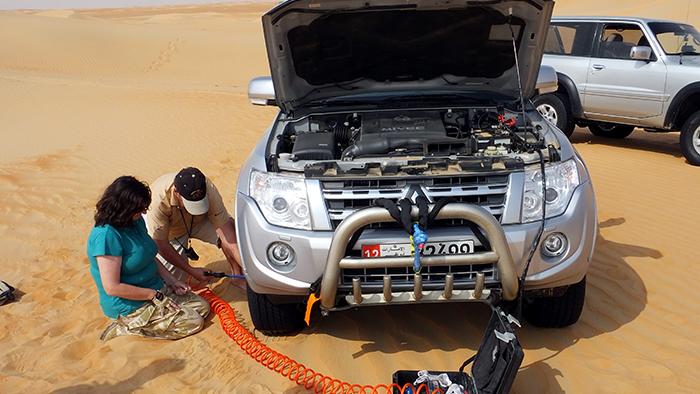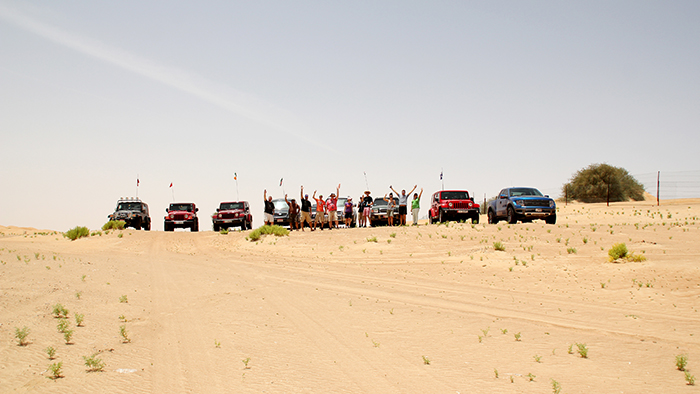Going out into the desert with your 4×4 can be a fantastic experience. You can enjoy the scenery, see some wildlife, meet new friends and learn a new skill. Offroading can be dangerous however, though knowledge and consideration of the risks can reduce them and make it safer. Trust me, you will never be able to plan for everything that could happen in the desert!
Cars can – and occasionally do – overheat, break down, have tyre issues, collide with objects, catch fire or roll over. Drivers and passengers can become overheated or fatigued, bitten by a scorpion or similar beastie, fall ill, become injured and sadly, in extreme cases, even die.
The desert is beautiful and enchanting, yet it is a very inhospitable and unforgiving environment. It’s important never to underestimate the risks mentioned above. Having driven in the desert frequently for over seven years now I am still learning and encountering new challenges when away from the tarmac. Planning is key to making the trip enjoyable and memorable for all the right reasons.
Managing the Risk 1: Pick the right people to go with
There are many good offroad clubs in the UAE running weekend trips where you can learn desert driving from more experienced people. Some clubs use the “coaching” technique, ie stop at obstacles, explain how to negotiate them safely, demonstrate, then let the rookies have a go; other clubs have a “follow the leader and you’ll pick it up as you go along approach”. Choose one that meets your preference.
There are also lots of individuals out there who are quite happy to take friends offroading, and providing they are suitably experienced in recovery and survival techniques a weekend camping trip is one of the best ways to spend Friday and Saturday.
Never, ever go out on your own. Even the best drivers make mistakes, lose concentration momentarily and get stuck or in trouble. If you only have one car on the trip and it breaks down, how are you going to get out of the desert safely? All too frequently local newspapers report on people dying in the desert, particularly in KSA, and almost invariably these vehicles have been crossing sand terrain on their own.
Even if you go out with friends, it’s important to limit yourselves to dunes and obstacles you have the skill for. Having a car “fly” over a dune might look good in a YouTube video but such momentary lack of control can cause injuries or damage your vehicle, so make sure you learn how to control your car in the sand before tackling any tricky terrain.
Managing the Risk 2: Have a minimum of three cars
Now I know that my husband and I frequently go offroading in remote locations with only two cars, but we have an immense amount of desert experience between us, well kitted out cars including one with a winch, and as ex-fire service in the UK, Neil is well equipped to cope with emergencies. So please do as I say, not as I do, at least until you get a few thousand kilometres of pure sand under your tyres!
The thinking behind the minimum number of cars is this – if you have three cars and one breaks down, at least you have two left to get out of the desert. Similarly, if one gets stuck, and the second one also gets stuck recovering the first, you then have the choice to use the third car to pull the other two out, or get out of the desert safely.

Waiting for early morning fog to clear
Managing the Risk 3: Check the weather forecast
Before we moved to the UAE we expected it to have perpetual sunshine for 12 hours a day, all year round but the reality is somewhat different. In the summer we often do have baking hot sun all day which brings the temperature up to 45-50C most days. It also makes the sand rather hot so always wear boots/trainers or closed in shoes. You can get hit by a sandstorm any time of year which greatly reduces visibility and makes recoveries difficult for those who have to get out of their cars. It’s definitely not the best weather for driving if you have a topless Jeep!
During the winter any area in the UAE is regularly blanketed in early morning fog, with zero visibility. When offroading, driving in fog is more dangerous than driving in the dark; you could literally slip off the side of a high dune as you have no idea of the terrain around you.
Managing the Risk 4: Take plenty of food and water with you
It is always better to have too much water than not enough – for an all day trip we pack a 24 x 500ml case which means we have 6 litres of water per person. We prefer these to larger containers – if we hit a bump hard then a large container could shatter meaning we have lost all our water, but it is unlikely you will break small bottles and certainly not all of them.
Take a bag with snacks such as nuts, crisps (chips), breakfast bars, boiled sweets and even tinned fruit to maintain your salt and sugar levels.
Always take a mat to sit on; sand is often very hot or damp (but never both!) and if you can, something to rig up some shade should need it –we sourced army bashas in the UK and these tarpaulins are very flexible and can even be used to create shade for vehicle repairs ‘in the field’.
Remember to pack a first aid kit and fire extinguisher too!
Managing the Risk 5: Make sure your car is properly prepared
You should go prepared to get stuck when driving in desert terrain – I always hope for a “Teflon” (non stick) trip but nine times out of ten this does not happen!
Heavy-duty recovery hooks on your vehicle are very important – some stucks are easy to recover from the back but others you have to pull forwards so it is important to have them on both the front and rear of the car.

Avoid driving over plants
Your vehicle should be up to date with servicing; remember here in the desert many manufacturers recommend an oil change every 5000kms. All known defects should be sorted before you take it on the sand; if it’s making weird noises on the blacktop then offroading will do it no good at all!
The condition of your tyres is very important and it is not a good idea to go out with old or defective tyres, or ones with damage to the valves, as unreliable tyres can be dangerous. Sometimes if you hit a plant side on with the tyre it will come off the rim, called a pop out and these are especially common with old tyres which have lost their sidewall ‘flex’; the good news is that the tyre can normally be re-seated whilst still attached to the vehicle. Do not forget to check your spare tyre, which should be in good condition, at full inflation, and matching the ones on the car. Make sure you have the tools and the know how to remove it from your vehicle!
Managing the Risk 6: Have at least one GPS device in your group
It is essential that at least one or two of the group have a good GPS which tracks where you have been – and someone should know how to use it! Plan a trip using Google Earth before you go, if only to put in a start and finish point and one or two intermediate waypoints. NB: If you have to abandon a car due to breakdown etc, remember to mark on your GPS where you have left it!
Managing the Risk 7: Ensure good communication
Always carry your mobile phone in the desert – the favourite areas for offroading have almost 100% coverage. (If driving in Liwa we recommend Etisalat as Du has poor coverage in some areas). Remember to charge your phone up before you go, make sure you have plenty of calling credit AND take your car charger for it too.
Leave word with your friends where you are going. On long ambitious trips we leave a trip plan with friends who are prepared to come and retrieve us or even alert the emergency services if we are seriously overdue.
If you are going into an extremely remote area, you could consider buying a satellite phone. These are about the price of a good smartphone but we consider the $50 annual subscription a small price to pay for added peace of mind.
The desert requests the pleasure of your company…
I hope I haven’t scared you off coming out in the desert, it’s such a wonderful environment and for most expats, so different from our homelands. Know the dangers, treat it with respect and you could find yourself
having a love affair with the largest sand desert in the world!
Words + Photos by: Marina Bruce



